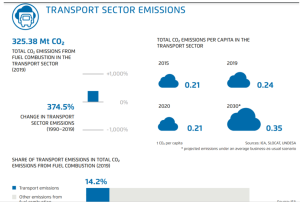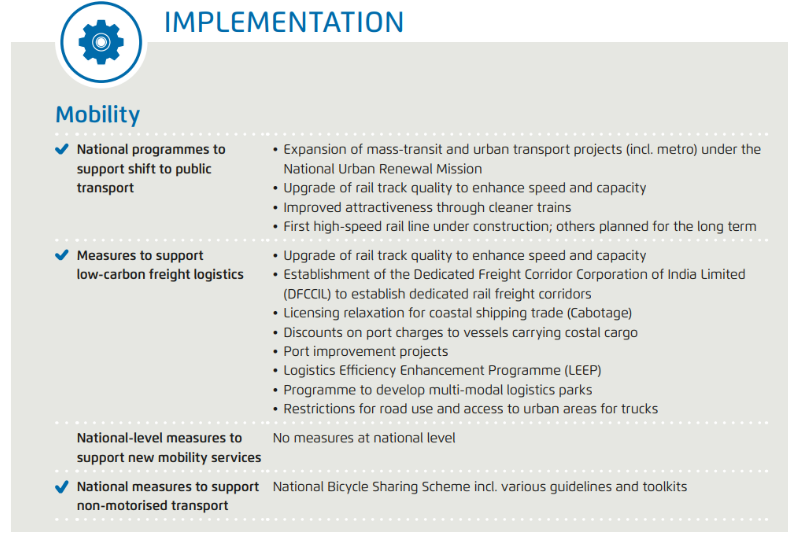Context:
Recently Niti Aayog released a report titled “Towards Decarbonising Transport – Taking Stock of G20 Sectoral Ambition”.
Highlight of the Report:
- Responsibility of G20: The G20 countries are responsible for a significant portion of global greenhouse gas emissions (GHG), making decarbonization of the transport sector crucial for achieving global climate goals.
- India’s Emissions from the transport sector could increase by 65 per cent by 2030 and a staggering 197 per cent by 2050 relative to 2020 levels.
- Lack of Commitment: Despite commitments to the Paris Agreement, the G20 has not given enough attention to decarbonizing and reshaping the transport sector.
- Snail Pace Policy Impact: Notable reductions in transport emissions have not been achieved since 1990, and emissions have been increasing due to motorization around the globe.
- Overall G20 transport emissions have grown by almost 6% in 2015–2019.
- Geopolitical Pressure: Due to the pandemic and growing geopolitical tensions, the international commitment to climate action is currently facing challenges.
- Tectonic shifts in geopolitics mean greater economic competition between China, India, and Indonesia, on the one hand, and the US, Western Europe, and Japan, on the other.
- Fuel Subsidy: Overall subsidy levels are still distorting the market, giving carbon-intensive modes of transport an undue advantage.

India’s Transport Sector and Carbon Emissions:
- Scope and Coverage: India’s road network is the second largest in the world after the US and it has the fourth-largest rail network globally.
India’s NDC Target:
- Committed to reducing the emissions intensity of GDP by 45% in 2030 relative to 2005 levels.
- Economy-wide net-zero target by 2070.
Transport related NDC targets
- Increase the share of railways from 36% to 45%.
- Signed COP26 ZEV declaration for new car and van.
- sales by 2040 (this also includes 2/3 wheelers).
Transport related NDC measures
- Promotion of hybrid and electric vehicles.
- National policy on biofuels.
- Passenger car fuel-efficiency standards.
- Promote coastal and inland waterway shipping.
- Construction of metro lines, urban transport, and Mass rapid transport projects
Future targets at national level
- 45% mode share for rail freight until 2030.
- Double the share of freight transported by coastal shipping and inland waterways
- 7,987 km of high-speed rail (in stages up to 2051).
National EV deployment targets
- 30% share of EVs in passenger LDV sales by 2030.
- 2,877 charging points in 25 states and 1,576 charging points across 9 expressways and 16 highways.
|
-
- The total number of road vehicles grew at an average of 10% per year between 2005 and 2012 and continues to grow strongly, which, together with increasing urbanisation, has led to high levels of traffic congestion and air pollution.
- India’s total CO₂ emissions from fuel combustion grew by 330% between 1990 and 2019.
- Emission from Transport Sector: Road transport emerges as the major contributor to sector emissions, closely followed by rail transport.
- Transport-sector emissions grew 375% over the same period and represent an uncharacteristically low share – 14% due to high carbon intensity of India’s power generation.
- With 1.6 t CO₂ for total emissions and 0.2 t CO₂ for the transport sector, India’s per capita emissions are the lowest in the G20.
- India’s rail transport’s share of sector emissions (nearly 7%) is one of the highest among the G20 countries.
- Slow Progress on EVs: Despite the global push to transition to electric vehicles (EVs), India has only set a target for a 30% electric vehicle share in passenger light-duty vehicle sales by 2030.
- It falls short of an overall emissions or energy target for the entire transport sector.
- Lack of Specific Target under INDC: India’s updated Nationally Determined Contribution (NDC) includes targets to reduce emissions intensity and increase non-fossil fuel-based energy resources, but it does not specifically address the transport sector.
Steps Taken to Control Transport Emissions in India:
- Ambitious Target: India aims to increase the share of rail in freight transport to 45% by 2030 and intends to achieve a 30% share of electric light-duty vehicle sales by the same year.
- India signed the COP26 declaration, setting a target to transition to 100% zero-emission cars and vans by 2040.Adopting greener policies in passenger and freight transport sectors to avoid up to 1.7 Gt CO₂e by 2030.
- EVs Push: Among G20 nations, India stands out for its rapid and impressive evolution in the EV market.
- Programmes: National Electric Mobility Mission Plan 2020 in 2013, followed by the Faster Adoption of Manufacturing of EVs (FAME) Phase I and Phase II.
- These programs have allocated $1.25 billion to incentivize EV adoption through upfront subsidies and the development of robust charging infrastructure.
- India has over 2.4 million registered EVs as of June 2023.
- Fossil fuel subsidy reform: India which phased out price controls for transport fuels in late 2014.
- From 2014 to 2017, India incrementally reduced oil and gas subsidies by 75%, while increasing funding for renewable energy six-fold.
- Hydrogen Push: India launched a National Hydrogen Mission in August 2021.
- Its target is to have 30 GW of electrolysis capacity by 2030 with related renewable power generation capacity, producing 5 million tonnes of green hydrogen per year.

Report Recommendation:
- Prioritizing Transport in Energy Transition: G20 states should lead in decarbonizing transport by eliminating fossil fuel subsidies and increasing green fuel funding.
Power-to-X technologies
- It encompasses various processes that convert renewable energy into other forms of energy or fuels.
- These technologies include power-to-hydrogen (P2H), power-to-gas (P2G), power-to-liquid (P2L), and power-to-chemicals (P2C).
- Power-to-X technologies are essential for achieving decarbonization in sectors like transportation, where direct electrification may not be feasible.
- By using renewable energy sources to produce hydrogen, synthetic methane, or other carbon-neutral fuels, these technologies offer alternatives to conventional fossil energy carriers.
|
-
- Fostering Just Energy Transition Partnerships and supporting power-to-X technologies for enhanced cooperation among member states.Adopting Power-to-X fuels: They refer to carbon-neutral alternatives to conventional fossil energy carriers.
- These fuels are produced by using renewable energy sources, such as wind or solar power, to convert water and carbon dioxide into synthetic fuels like hydrogen or synthetic methane.
- They can play a crucial role in decarbonizing sectors like long-haul aviation and maritime shipping, where direct electrification may not be feasible.
- Greener Funding: Increasing investments to more energy-efficient means of passenger and freight transport can help shift consumer demand toward lower-carbon transport.
- India has set a target to move at least 50% of goods via rail by 2030 and fully electrify its rail system by 2024.
- Adopting “Avoid, Shift and Improve” strategy: This strategy emphasizes the need to avoid unnecessary vehicle trips, shift towards low-carbon modes of transport, and improve the efficiency of existing transport systems.
- Sustainable Mobility: The transition to sustainable mobility will reduce energy consumption without limiting mobility.
- Enhance the availability and cost-competitiveness of public transport and to support both the electrification of vehicles.
- Electric vehicles (EVs) can improve energy efficiency by producing about 20% less CO₂ emissions than internal combustion engines.
- Integrated system approach: Combining IT, transportation, and power grid expertise can enhance integration between power and transportation sectors, promoting decarbonization in transportation and the energy economy as a whole.
- Role of Legislation: Countries must pass laws promoting new ideas, accelerating low-carbon system expansion, and holistic policies, addressing energy and land use linkages..
- Ex: Public transport infrastructure is crucial for reducing GHG emissions, improving urban quality, and reducing congestion and fatalities.
- Behavioral Change: G20’s 2019 Energy Efficiency Leading Programme (EELP) recognised the importance of “behavioral change”
-
-
- Policies should promote eco-friendly, efficient transportation options like walking, cycling, and public transport, while promoting electric vehicles.
Just Energy Transition Partnerships
- It is a collaboration between G20 member states that aim to support the market ramp-up of power-to-X technologies.
- These partnerships involve adopting ambitious policies, increasing funding, and providing guarantees for investors.
- The goal is to produce green power-to-X fuels in substantial quantities, which can replace conventional fossil energy carriers with carbon-neutral alternatives.
|
News Source: NITI Aayog
![]() 16 Aug 2023
16 Aug 2023


